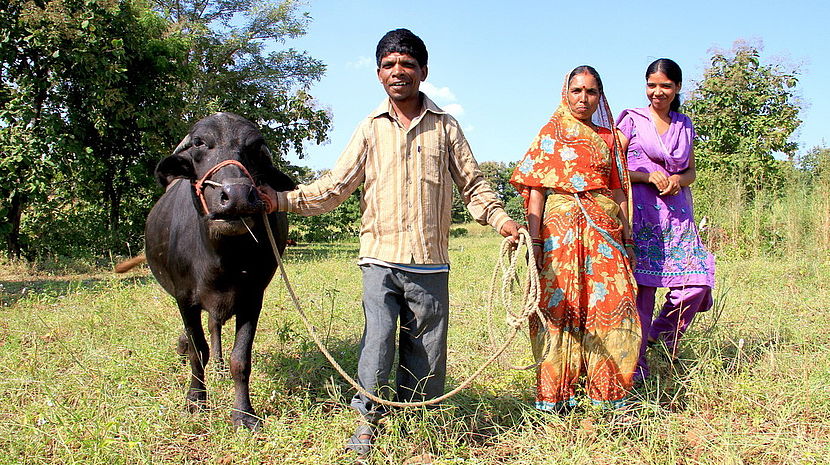World Humanitarian Day 2016

19 August is World Humanitarian Day, a time to recognise those who face danger and adversity in order to help others. This year, CBM highlights the Humanitarian Disability Charter, which sets the agenda for a more inclusive future in humanitarian action, and interviews Habtamu Haile, Emergency Programme Manager in Ethiopia.
One Humanity - Full inclusion
The 2016 theme for World Humanitarian Day is 'One Humanity' - with more than 130 million people around the world in need of humanitarian assistance to survive, the UN and its partners are using this to call for global solidarity. The theme also reflects commitments made at the World Humanitarian Summit
in May in Istanbul, to support people affected by crisis and ensure that aid workers can safely and more effectively deliver to those in need.
This year CBM focuses in on this theme, and its relevance to the Charter on Inclusion of Persons with Disabilities in Humanitarian Action. 'One Humanity' implies full inclusion. This groundbreaking document reiterates the extra challenges faced by persons with disabilities in receiving humanitarian aid, makes links with the 2030 Agenda for Sustainable Development, and - crucially - highlights the need for meaningful participation of persons with disabilities in crisis preparedness and response coordination mechanisms. The Charter has already been endorsed by more than 100 bodies, including States, UN agencies, organisations representative of persons with disabilities, international and non-governmental organisations. In short, it sets the agenda for a more inclusive future of humanitarian action.
Interview - Habtamu Haile, Emergency Programme Manager for CBM in Ethiopia
- Can you describe the work you are doing in Ethiopia? We are working with our local partner ‘Organisation for Rehabilitation and Development in Amhara’ (ORDA) to improve the living condition of communities affected by the El Niño drought. Our aim is to increase the resilience of the people who are most at-risk by using various strategies, including reducing school dropout rates through disability-inclusive school feeding programs, increasing agricultural production levels – providing seeds and small animals – and creating and restoring dams for water harvesting. And looking long-term and beyond our own programmes we are encouraging disability-inclusive Disaster Risk Reduction (DRR) in local authorities’ plans and policies.
- What does ‘disability inclusion’ mean to you? To me, disability inclusion means ensuring that people with disabilities can access our emergency relief services as easily as anyone else. It also means ensuring that we consult with these people when planning our response. But our relief work does not aim to target only people with disabilities – our approach to inclusion is that everyone is reached; we just put more effort into ensuring marginalised groups are part of this.
- Why is this essential? It is essential because we – all humanitarian workers – want to make sure nobody is left hungry or cold or lonely when there are natural disasters or conflicts. People with disabilities have the same rights as everyone else to live in safety and comfort, and to have their opinions heard when decisions are being made about them. But very often they are the last people to be thought about, or they cannot access aid or take part in meetings because maybe the location is not accessible, or the information was not provided in a format they can understand… there are many ways people can be excluded. We want to leave no-one behind.
- How does it affect other members of the community? Including people with disabilities has no negative effects on the rest of the community. Including people with disabilities when we plan our work makes sure that they are properly identified when the aid comes and makes sure any specific needs they might have are noted. And all the things we do that remove barriers to aid for people with disabilities can be useful for other people – including older people – so in fact it always benefits others. The result of all of this is a stronger community.
- What are the biggest challenges in your work? We have some practical challenges, for example the large distances and challenging road conditions and poorly accessible areas, or communications where there may be no network. And there are challenges coming from the fact that people with disabilities are often excluded from society, through negative attitudes and beliefs – changing mind sets and attitudes takes a long time, but having persons with disabilities as role models helps to do this. They may also be in a different situation to other members of their community – for example they often have less or no farmland, meaning seed distribution may be less appropriate than distribution of small farm animals. Sometimes we find people who need new prosthetics, or crutches. So when we do needs assessments we take note of these specifics and try to adapt our response to best meet the specific needs of the people.
- What do you most enjoy about your work? I am helping people in need who face extra barriers. I enjoy this very much.
- Can you tell us a little about yourself? I am married with three sons (the older two are 14 and 8 years and the third one is 6 months old). My wife is a teacher. I have been working in this field since 2010, before CBM I had experience with refugees, in child protection, and other areas of development. In the past I was a teacher – this is how I met my wife. I have also been an aerodrome air traffic controller.
More reading
CBM working with local partners to ensure that people with disabilities are included at all levels of disaster preparedness and response
Humanitarian Action